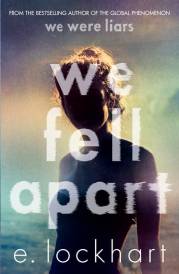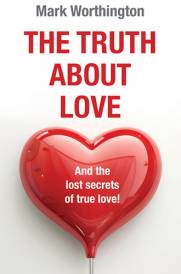Nicole Kidman Destroyer
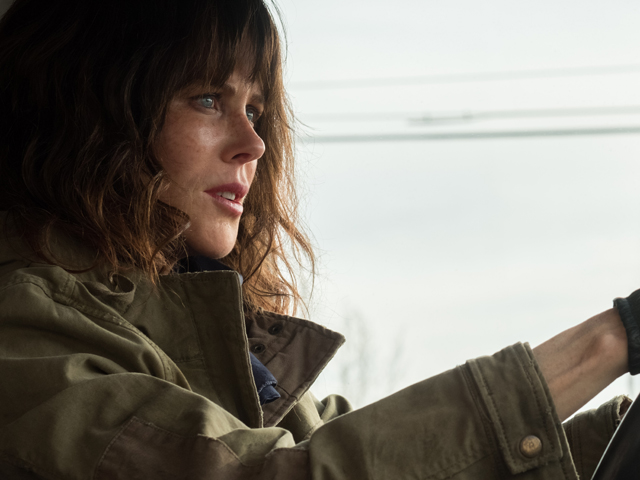
You Can't Run From Yourself
Cast: Nicole Kidman, Toby Kebbell, Tatiana Maslany
Director: Karyn Kusama
Genre:
Rated: MA15+
Running Time: 121 minutes
Synopsis: In Karyn Kusama's riveting new crime thriller Destroyer, the receipt of an ink-marked bill in the office mail propels veteran LAPD detective Erin Bell (Nicole Kidman) on a perilous journey to find the murderer and gang leader, Silas (Toby Kebbell), and perhaps to finally make peace with her tortured past.
Written by Phil Hay and Matt Manfredi (The Invitation, Crazy/ Beautiful) who also produced the film alongside Fred Berger (LA Land, Oeration Finale), the richly complex odyssey through the underbelly of Los Angeles and nearby desert communities reunites Bell with members of the criminal gang she once joined as an undercover FBI agent; an assignment which ended disastrously and has taken a heavy emotional and physical toll on her life.
One by one, she tracks down the gang leader's former cohorts including Petra (Tatiana Maslany, ORPHAN BLACK), Silas' onetime lover and current errand girl. During her obsessive search, Bell is flooded with memories of her undercover days with Silas' gang and her involvement in a bank heist gone tragically wrong. Especially painful are her recollections of Chris (Sebastian Stan, I, TonyA), the FBI partner with whom she had a brief but meaningful romance.
Destroyer
Release Date: March 21st, 2019
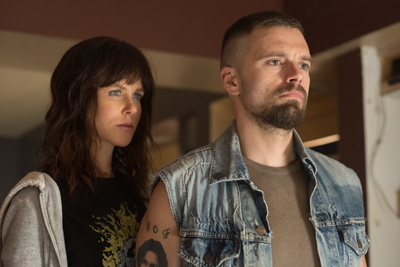 Director's Statement
Director's Statement
Destroyer is, at its core, a film about confronting your mistakes and making the brave decision to be accountable for your actions. Within the relatable frameworks of crime thriller and cop movie, it's also an insistent character study, hinging on the wounded but resilient psychic landscape of an LAPD detective named Erin Bell. The criminal underworld she investigates, alongside a storytelling structure that allows for narrative surprise, recall films like Heat and The Usual Suspects. But the film also allows intimate access to her in a tradition of genre films as varied as Taxi Driver, A Prophet, or Nightcrawler. It's made more modern and relevant by its complicated female lead, and I can't think of a time when I've loved a character more.
The look and feel of the film reflect the world of extremes it inhabits: a seductive mirage of blasting Los Angeles sunlight and dreamy blankets of coastal fog, fuelled by the sonic assault of 1990's desertmetal and the pop confections of today's top 40 radio. Though Destroyer moves between two distinct timeframes, it primarily occupies the Los Angeles of today, a 21st century melting pot of corrupt lawyers and small-time crooks, gun dealers and local preachers, hard-working middle-class laborers and charismatic charlatans. This vast city, connected by sprawling freeway systems and dotted with neighbourhoods as diverse as its people – is itself a mirror of Erin Bell's divided soul: humming with secrets and lies, struggling to find what's real in a landscape of carefully cultivated surfaces. While much of the visual approach to the film should be undeniably visceral and raw, there are opportunities for unexpected beauty and lyricism. The moments of redemption, both visual and moral, should be rare but hard-won.
Destroyer aims to uncover all kinds of primal "destroyers" – money, greed, hunger – but will also reveal the insidious qualities of memory, denial and the inexorable march of time itself. While society's destructive impulses seem to have reached an apocalyptic peak, it's still the peculiar will of an individual to sabotage herself that I find the most compelling and human to explore. In witnessing Erin Bell's self-destruction, we are forced to confront our own personal "destroyers." In the end she pays a terrible price for her redemption, but she finds it, nonetheless. The audience experiences the spiral of regret and shame that powers her odyssey back into the past, but also witnesses the heroic journey of a morally compromised character, a woman who eventually decides to right a wrong at any cost.
As a parable, Destroyer is a bracing "woman-against-herself" story, a sustained howl whose story, I hope, belongs to all of us.
- Karyn Kusama
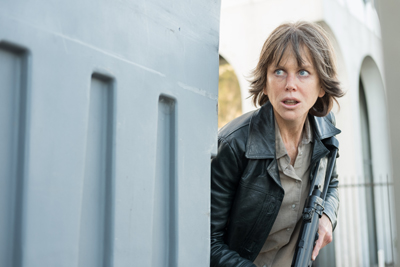 A Family Affair
A Family Affair
The script for the action crime thriller Destroyer was born over an extended period of time. For several years, while also working on various other projects, writer/producers Phil Hay and his long- time co-scenarist Matt Manfredi began compiling ideas for a screenplay based on their mutual love of crime movies and their interest in Los Angeles' diverse neighbourhoods and populations. "What excited me," says Manfredi, "was writing a novelistic movie with an emphasis on character, a style reminiscent of classic 1970s cop films like Serpico and The French Connection."
As they began conceptualizing the story and gathering plot details, the screenwriting duo found their central character, a loner cop with many secrets both professional and personal. "It evolved into a multilayered story that took place in the main character's past and present," says Hay. Technically speaking the concept presented logistical challenges, given the story's multiple time frames and the fact that "even the past sequences are not necessarily chronological," Manfredi observes. "It took a while for us to get the plot details to where they were seamless and not confusing. We stepped away from the project several times to clear our heads and then came back to it."
As they refined the story, the pair received a spark of inspiration from Karyn Kusama who was already on board to direct. "For years, Phil and Matt had been discussing a crime story that explored patterns and circularity in both its plot and themes," says Kusama. "In between, there would be an examination into the conscience of the character. Once the three of us started talking about it together, we collectively realised that this needed to be a story about a woman. That was the spark. Erin Bell was born out of that."
The screenwriters took extra care that Bell not be simply a troubled male cop presented as a woman. "As always, Matt and I seek to create characters who are living lives that exist outside of the plot of the movie and whose problems are unique to them," says Hay. What emerged was a complex, timeshifting story that is in part "about a woman coming to terms with how she's lived her life and trying to find some way to move forward," says Hay. "But it's also a crime thriller about someone who, when she was younger, was placed in a dangerous situation she couldn't handle and has been living with the repercussions ever since. Additionally, it's a manhunt about a woman who is on an obsessive and destructive mission, the consequences of which are slowly unveiled."
In the story, Bell can be an unpleasant, uncompromising person, often to her own detriment. One challenge was finding the emotional core in a character for whom the audience might not automatically feel a great deal of empathy, says the screenwriters. "Erin's constantly breaking rules. She's a bad partner and a bad mom but even though she messes up, she keeps trying," says Manfredi.
"There's something so relatable about her persistence even though, with all the best intentions, her plans often go awry. We tried to draw her in a charismatic way, as a force of nature, so that even when she's doing things that are questionable, you keep hoping that in the end, she will be able to heal this wound that happened long ago."
From the first draft of the script, Kusama was fascinated that Hay and Manfredi had introduced a mother-daughter dynamic into the story, something she'd never witnessed in the context of a police crime thriller. "It felt very different to me, very fresh, a kind of aesthetic sweet spot that expanded the genre in terms of emotion and character," she says. The personal elements of Bell's story, she continues, transcend the Hollywood fantasy of the lone-wolf law enforcement figure.
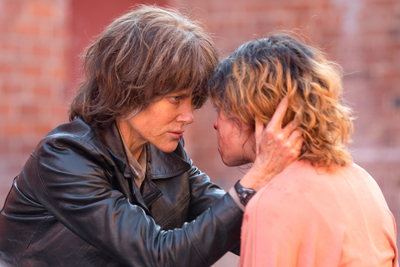 "In reality, it's a rare thing to find someone who doesn't have any personal attachments outside the job," according to Kusama. "I was fascinated by the additional complication of Erin, who is in the midst of a manhunt, having a struggle with her daughter from whom she is estranged. We can see that, while she is competent at her job, she's also kind of a mess. Her life seems to be unravelling. I thought it was wonderful that Phil and Matt just let her be a mess and took us down that rabbit hole. Perhaps some of us will see a version of ourselves in her plight."
"In reality, it's a rare thing to find someone who doesn't have any personal attachments outside the job," according to Kusama. "I was fascinated by the additional complication of Erin, who is in the midst of a manhunt, having a struggle with her daughter from whom she is estranged. We can see that, while she is competent at her job, she's also kind of a mess. Her life seems to be unravelling. I thought it was wonderful that Phil and Matt just let her be a mess and took us down that rabbit hole. Perhaps some of us will see a version of ourselves in her plight."
While the story is laced with characters whose motives are sometimes as circumspect as Bell's, the city of Los Angeles and its surrounding desert communities have a co-starring role as well, say Kusama and the screenwriters. The environment, through which Bell pursues the bad guy, tries to repair her broken mother-daughter relationship and wrestles with her personal demons enhances the story, giving it a specificity and unique flavour.
As the grizzled detective pursues her nemesis and his-cohorts, she spends a great deal of time behind the wheel of her car traveling to various parts of the city and its environs to areas that are definitely not postcard pretty and which even many native Angelenos have never explored. "The script realistically lays out Los Angeles," says Hay. "The neighbourhoods have character and Erin's travels from one part of the city to the other are an almost epic journey. Even the individual freeways have their own purpose and personality."
Shooting a crime noir in direct sunlight (and also murky, seedy interiors) was a cinematic plus for Kusama. It evoked images of other classic Los Angeles set detective movies such as Robert Altman's The Long Goodbye and Kathryn Bigelow's Point Break. Claims Kusama: "In college, I must have seen Point Break twenty times in the theatre. I've always appreciated epic crime stories where you have to dig in with a bunch of characters. And this story gave me that opportunity. It just called out to me."
Unlike most independent projects, while the script's development may have been extended, the filmmakers search for backing, and later a leading lady, proved relatively brief. Producer Fred Berger, a long-time admirer of Kusama's work, had approached her with various projects. "I kept sending Karyn material because her body of work displays such an understanding of big screen visceral filmmaking and with a unique point of view. I have always been struck by her passion and her sense of humanity."
Berger's response to the Destroyer script was immediate. "I was blown away," he says. "I can count on one hand the number of times I've read a script that had that kind of impact on the first read. It started off with a bang and just kept going. The writing, the control of language, the control of tone and pacing were confident and immersive. The script delivered cinematically and from a character point of view, it plumbed the depths of the central character's past and present. I saw it as a roller coaster, adrenaline fuelled experience in which you never see the twists and turns coming. And beneath it all is this absorbing character study, that's both psychologically and ethically nuanced. I was just dying to be a part of it."
Particularly satisfying, notes Berger, is the fact that the storyline pushes the limit of the police detective genre, juggling time frames with satisfying action set pieces and surprise reveals all built around a challenging central character "who is at best an anti-hero, and certainly someone who has made some morally compromised choices. For all that, there is no wasted time in the story, no wasted characters."
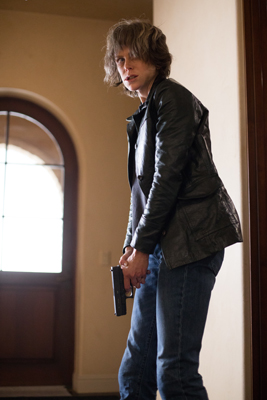 The Bell Curve
The Bell Curve
The search for the right actress to embody the character of Erin Bell was over before it began. Due to their track record, the Destroyer filmmakers already had financing in place, but were more interested in finding an actress with the chops to handle the complex role of Bell, who appears in virtually every scene. "We never thought of going after a big-name actress in order to secure financing or a top movie star for the poster," says producer Berger. "We were looking for someone who would be a revelation in the role."
The filmmakers were just beginning to explore their options when a major talent, the versatile Oscar winner and four-time nominee Nicole Kidman asked to meet with Kusama after reading the script. "I had already been following Karyn's career and was really interested in the combination of her with the material," says Kidman. "I wanted to meet with her and understand her vision, and when I did, I felt her passion and commitment. I love being involved with a project when someone is completely uncompromising and passionate about their work."
Says Kusama, "For me, it was mind blowing that an artist of Nicole's calibre would be interested in our movie – it's such a complete departure from the rest of the body of her work. It showed such a sense of daring and curiosity, which is why she's the artist she is." Of course, Kidman had the filmmakers at from the get-go. "Nicole is an actress who has never made safe or easy choices," says Berger. "Over the past few decades, she's delivered some of the best film performances, and more recently TV performances like her shattering Emmy-winning work in the limited series Big Little Lies."
"One of the first things Nicole said was 'I don't want people to see me up there on screen. I want them to see Erin Bell.' And as she talked about the character, we realized that she had a specific and visceral gut feeling for who this woman was," says Hay. "Part of what fascinated me," adds Kusama, "was that Nicole has never done this kind of role before. It felt so fresh and the idea that an actress with her range and depth was going to tackle all that animus and aggression really excited me."
Kidman explains that she viewed Bell as "someone who was scared and damaged by her own choices and also by the cards she had been dealt. Her path during the film is painful but it is also her way of finding salvation. The layers and complexities of her anger and her shame, her inability to express her emotions, and her shields and barriers were very powerful; so too was her inability to express how she felt about her daughter, while at the same time trying to forge a better life for her. I found her pathos touching."
Once Kidman had signed on to the project, it opened the door to other top-flight talent, all of whom were eager to work with her, according to Kusama. Additionally, "Karyn is a true actor's director," says Berger. "Working with our casting director, Mark Bennett, they were able to find actors, even in the smaller roles, who had the chops to go head to head with Kidman and some of the bigger name performers."
The pivotal role of Chris, Erin Bell's onetime undercover detective partner and lover, was cast with the seasoned and appealing Sebastian Stan. Says Berger, "Sebastian has been doing strong work for years, though not the kind of flashy stuff that usually gets attention. But look at his work in I, Tonya. He stole scenes against two Oscar nominated actresses." Adds Hay, "from the first conversation Karyn had with Sebastian, we knew we had to have him in the movie."
For the role of Silas, Bell's elusive prey and the former gang leader who has haunted her life for the better part of two decades, Toby Kebbell was cast, who recently made an impression in War for the Planet of the Apes and Kong: Skull Island. "Toby is a true artist," says Hay. "He brought a lot of different and interesting aspects to the table. He's funny and charming, but he's also very physical and he projects a real sense of power."
Tatiana Maslany was an eager and apt choice to play Petra, the drug addicted spoiled-rich-girl gang member, who like her former boyfriend Silas, is on the downslide. "Anyone who's ever seen Orphan Black knows there's nothing outside her bounds," says Berger. Adds Kusama, "What I love about Tatiana is that she's a total shape-shifter of an actress. She can do anything."
Other key roles were assigned to Bradley Whitford, Scoot McNairy (Godless, Halt and Catch Fire), and Jade Pettyjohn (The United States Of Tara and the television series School Of Rock).
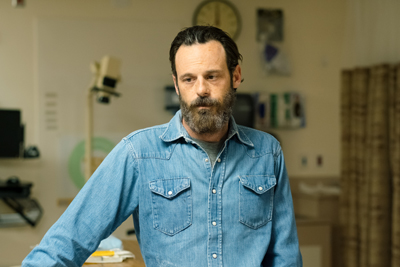 The Collaborators
The Collaborators
Destroyer was shot entirely on location in Los Angeles and its environs, an attenuated schedule that might daunt even the most agile director. Kusama, however, never broke a sweat, according to producer Berger. "Karyn is one of the most well prepared and professional filmmakers I've ever met," he says. "She knows every aspect of filmmaking from top to bottom, from prep, to production to post."
Adds Manfredi, "The great thing about Karyn is that she's so meticulous and focused. She's very collaborative but at the same time, she knows exactly what she wants and how to achieve it."
Kidman was also impressed by Kusama's directorial approach: "Karyn is very precise and yet wants to hear your thoughts and ideas and meld them into her vision. She's a leader and a filmmaker with a strong sense of what she does. She's prepared and thoughtful and maternal, yet she's scrappy and not frightened of digging in. Since her husband and his best friend wrote the screenplay, having the three of them together was lovely because they were able to support and boost each other."
While Kusama storyboarded her scenes, she was open to adjusting for the inevitable changes required for location shooting. The one major exception was the bank robbery action set-piece, which had to be carefully laid out "because we were using live gunfire and in-camera effects, and you can't do endless takes. You have two or three shots at best before you run out of time and ammo," says Kusama.
The exquisite preparation enabled Kusama to work closely with her actors, particularly Kidman who plays Bell in her current, embittered incarnation as well as her earlier persona as an FBI undercover detective. "Part of my job," Kusama says, "is being present with my actors. Nicole was always thinking, feeling and working things out the character. And I had to communicate with her as well as the other actors since, in playing Erin Bell, she was living in this nether zone even when she was off-camera."
"From day one, working with Nicole was a total joy," says Berger. "When she's on set, there is no fanfare. It's all about the work. She was in the trenches with us from the get-go, a true partner in the process. We were making a film with budget and time constraints and she was always there to help us if we were in a moment of crisis." Adds Kusama, "Nicole is a true artist in that she channels her energy and lives in that energy, then walks away from it at the end of the day. I can't imagine that was easy, but it certainly was exciting. There were scenes where I was just sitting there watching her take it to the next level. To be able to witness an artist plumbing those depths was pretty thrilling."
"Nicole has a deep well of emotional intelligence that she brings to every scene. When you watched different takes of each scene, you'd see her probing and asking little questions with the same line, providing us with a wealth of options. It's a smart and brave performance," says Manfredi. According to Berger, "it was thrilling to watch Nicole's physical transformation, her walk, her voice, the humanity in her eyes. She brings added thematic tension to the story in its exploration of what it means to be a mother who has made some terrible mistakes. Erin is destroyed by guilt and is attempting to find some means of redemption and Nicole handled it not in the traditional way, but with subtlety and complexity. It's a true virtuoso performance. And when you add a distinguished talent like Karyn as her director, you have a partnership that brings a unique female perspective to the story."
To play Bell, Kidman had to learn how to shoot and handle guns and to behave like someone who is both hunter and prey, who "watches the world through the lens of someone who is always under threat," as she puts it. According to Kidman, this even affected how she walked into or exited a room: "Erin immediately knows how to protect and attack. That was new to me and I wanted it to be real and accurate. It took a while, but I began to walk differently, behave differently, even think differently while I was playing her."
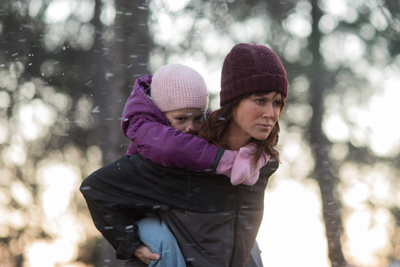 Explaining her process of unearthing the character's psychology Kidman says, "In certain roles, I'm playing someone so physically and emotionally different from who I am that I have to transport into a different place, to step out of what feels like 'performing,' which I'm not interested in. That's what the limbo is. It's uncomfortable and quite unpleasant to be in that space. I don't enjoy it. But I'm also deeply committed to my artistic path, and that happens to be a big part of it. There can be joy in certain roles. Others are going to be uncomfortable and here we were telling a story about a character who is in a great deal of discomfort. Karyn and I had to test our psyches by being there with the character the whole way. We were bearing witness for women like Erin Bell whose lives are thorny, women who've had to make so many compromises."
Explaining her process of unearthing the character's psychology Kidman says, "In certain roles, I'm playing someone so physically and emotionally different from who I am that I have to transport into a different place, to step out of what feels like 'performing,' which I'm not interested in. That's what the limbo is. It's uncomfortable and quite unpleasant to be in that space. I don't enjoy it. But I'm also deeply committed to my artistic path, and that happens to be a big part of it. There can be joy in certain roles. Others are going to be uncomfortable and here we were telling a story about a character who is in a great deal of discomfort. Karyn and I had to test our psyches by being there with the character the whole way. We were bearing witness for women like Erin Bell whose lives are thorny, women who've had to make so many compromises."
Taking on the key role of Chris, Sebastian Stan had only a limited amount of screen time to make an impression. According to the filmmakers, he more than provided himself. In fact, he provides the film with "an important emotional touchstone," claims Hay. "Sebastian took the character of Chris beyond what I had expected, and he became a giant part of the movie's fabric." As he most recently demonstrated in I, Tonya, working opposite top calibre actresses only served to heighten his already gifted abilities. "The chemistry between Sebastian and Nicole is palpable, a real electric connection," says Berger. "He goes toe to toe with her in every scene, which when you consider the magnitude of his co-star that is quite impressive. From their very first scene, they were natural and fluid together. It's one of those magnetic connections that can't be created artificially. It speaks to the magic of the movies."
Kusama is unbridled in her praise for Stan's work. "What's so beautiful about the performance is that from the moment he steps on screen, Sebastian projects a no-nonsense, dependable guy image; a man on a mission who is there to take care of business. He invested the role of Chris with a classic leading man charisma, but never overplays it. As the story progresses, he lets us see that Chris is also human; that he's beginning to enjoy this undercover assignment and his tenderness for Erin becomes real. While in screen time, we don't see that much of the developing relationship, he and Nicole projected such chemistry that they were able to shorthand it, beautifully so. We come to understand that what's between them is authentic."
Toby Kebbell's performance as Silas was also imbued with the kind of dimension that left the filmmakers elated. "Toby brought unexpected humour and lightness to his volatile, explosive character, which was totally in keeping with Karyn's vision of going for the unexpected," says Berger. "He could easily have been a stock villain, but instead brings an unpredictable energy that really elevates the movie. He's a worthy foil for Nicole's Erin Bell." Adds Kusama, "what's wonderful about Toby is that he went completely against all the stereotypes we have for that kind of character: instead of playing Silas as a diabolical mastermind, he explored the small, wormy, side of him. Someone who is self-aggrandizing but also totally wrong, a small-time sleaze ball. That smallness helps guide the audience to a larger question about Erin's real motives."
Taking on the character of Petra, whom Hay describes as a "rich miscreant who has tragically gone on a terrible path for reasons that are not totally her own fault," Maslany invested her with "a humanizing element of pathos, again bringing added nuance to the material." Observes Kusama, "Petra is a wellto-do Beverly Hills girl who, by the time she's eighteen, has fallen off the cliff due to substance abuse. When we see her seventeen years later, like Erin, she is a wreck. Not only has the long-term drug use damaged her physically, but she's not even in her right mind anymore. Tatiana relished the idea of playing someone who is not completely tethered to reality. What's really impressive is that, despite the long-term effects of Petra's drug use, Tatiana was able to tap into the character's survival instincts. To survive that long under those conditions takes a great deal of stamina. The way she plays her, Petra comes off as a tragic character. And you wind up feeling a kind of sympathy for her. Even to the end, she still sees herself as privileged."
Of their working experience, Kidman says she found Maslany to be deeply talented and that the relationship between Petra and Erin was organic. "It just started and built," she says. "It was very intuitive and very real. She's the real deal, Tatiana."
Kusama's instinct to cast the role of Erin's rebellious sixteen-year-old daughter Shelby with an actress who is the same age paid off handsomely. Despite the time restrictions imposed when using an actor who is under the age of eighteen, Jade Pettyjohn, "who already has a list of impressive professional credits," says Kusama, "was not only well prepared to take on the role but she still had some baby fat in her face. She looked like someone who is just stepping out of childhood. I wanted to remind the audience that despite her rebellion, she was still a girl crying for her mother's attention." Adds Berger, "Jade was amazing as Shelby. In what was potentially the most challenging role in the film. It's so rare to find a sixteen-year-old who can understand the depth and complication of their final scene together, but from Jade's first reading she had us in tears."
All of the supporting cast in Destroyer is top notch. Even Bradley Whitford, who makes a brief appearance as the money launderer Dennis DiFranco, brought his A-game to the role. "Like Toby, Bradley completely embraced the ugliness and weakness of his self-aggrandizing character. He really got into the character and relished playing him," says Kusama.
 That Face, That Face
That Face, That Face
In a film rich with visuals, the most immediate and most shocking one is the first appearance of Bell. While recognizable, Kidman is utterly transformed; the character's face and physique show years of neglect and distress. Her eyes have a haunted quality. The exterior became her roadmap of the character's internal life, according to Kidman. And it was the brilliant transformative abilities of Academy Awards winner and three-time nominee Bill Corso that helped her unlock the character. In the past, Corso has brought his makeup wizardry on such films as Foxcatcher, Deadpool and its sequel, Star Wars: The Force Awakens and his award-winning A Series Of Unfortunate Events.
"When Bill started putting together Erin Bell's look"showing my life on my face, on my body"I realized the extent to which she was broken, in distress. I needed to make her authentic outside and in," says Kidman, "not only on my skin, but in my shape, in the way I move. It was scary, but at the same time incredibly freeing." Kusama confesses that she was shocked the first time she saw Kidman in full makeup, "especially since Nicole takes such good care of herself and has this gorgeous porcelain skin. Whereas as Erin, her skin has a kind of leathery quality that can happen in the perpetually sunny climate of Los Angeles and the desert."
The beaten-up look provided a visual short cut to understanding the character's psychological state, Kusama and Kidman agreed. "Erin's face is a map of time and regret," says Kusama. "And drinking," adds Kidman. "She has deliberately sabotaged her body and it shows her desire to hurt it." Nowhere is this contrast more pronounced than the scenes of Bell in her earlier days as an undercover FBI agent. "When we see her in flashback, events that happened seventeen years earlier, we are even more startled by her decline," says Kusama. "In the flashbacks she's fresh and open and there's a kind of reckless enthusiasm about her. She was working undercover then, and she and her partner, who were playing a couple, actually fall in love. And we see that light in their eyes whereas, in the present, we see what's happened to her as a result of losing all of that."
"The makeup process required extensive planning and testing to make certain that in both timelines it looked organic and natural," Kusama explains. "In the flashback sequences, Corso gave Kidman a rosy complexion with tiny freckles and a kind of luminescence. For the present-day scenes, he created layers to give her face an uneven look, using pigmentation and sun spots, prosthetic eye bags, a broken nose and stained teeth. Corso created the wrinkles on her face through stippling that tightens the skin and produces age lines. Nicole hated sitting in the makeup chair, but Bill eventually got it down to about forty to forty-five minutes. It took as long to remove as to apply it."
The Real Los Angeles
Shot completely in and around Los Angeles on a restricted schedule and using no soundstage sets gave the film an unmistakably realistic look. "Everything you're seeing is a real place," says Kusama, "and there was nothing to build, which was freeing, but it also meant there was no down time. Sometimes we shot in two or three locations in one day. I usually work fast but that was a challenge even for me. But then, anytime you're shooting with less of a budget than you really need it's a challenge."
"I loved shooting in Los Angeles," says Berger. "It gave us an opportunity to see the city in ways that you would not otherwise. We were able to explore corners of the city you wouldn't otherwise traverse. You could never have dressed the sets this way or gotten the same look if you were shooting say in Vancouver. You can feel in your bones that it's L.A., its immediately recognizable–from the street signs, to the roads, to the churches to the cliffs. Anyone who lives here will appreciate the authenticity."
Manfredi concurs: "what could be more L.A. than scenes in cars? There's a lot of driving in the movie. We're either behind Erin looking out at L.A. or looking at her face, and it's all very stripped down, very gritty. Changing locations every day meant we had to be light on our feet, and that brought a kind of energy to the shoot."
Along with the realism, the production also courted some danger. "In South Central Los Angeles, we had to make overtures to the gangs and make sure that they were cool," says Berger. "They left us alone and were very gracious. But once, there was a shooting nearby and we had to put everyone in an armoured car and lock up the base until we were sure everyone was safe."
In keeping with a visual approach, which she refers to as "sunlit noir," Kusama studied the work of such renowned photographers as Fred Herzog and Beatrice Minda. As with her other films, she created a "look book," which in addition to photographs, included film stills and documentary photos of crime scenes. "I used it to help me wrap my brain around the material and to frame scenes. Though I was always spontaneous when on location since other factors intervene. Even while prepping I made some detours. It was exciting to work that way. Part of being a director is problem solving – and to embrace that you sometimes have to surrender to them."
Director of Photography Julie Kirkwood is responsible for creating the film's seedy, chiaroscuro ambience, a look that Kusama describes as "this kind of blown out L.A. sunshine. And what that does in terms of atmosphere is create a more mysterious frame to the story." Kusama had previously met Kirkwood while searching for a Director of Photography on an earlier film. She had been struck by Kirkwood's intelligence and her photographic eye as it pertained to illuminating character development and she seemed the perfect choice for Destroyer. "Julie is a tremendously exciting talent," says Berger. "She created a seamlessness between the past and present sequences that had a natural flow. Not at all gimmicky. She was as much at ease with the characters scenes as the action set pieces. The city of Los Angeles has an almost palpable persona in the film. She captured that harsh light that just hits you in the face. It's gritty without being dirty or dark."
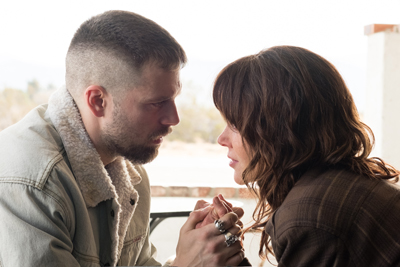 Kirkwood was ably assisted by Robert Foulkes, the film's Location Manager," adds Manfredi. "He found parts of L.A. I didn't know existed and I was amazed every time. He discovered a house deep in Palmdale, and to this day, I don't know how he even knew that house was there. But it was perfect for the scene we were shooting. He also found a little strip of land that overlooks Dodger Stadium with downtown in the background. Places like that were vital to giving us a look at L.A. that sets it apart from other movies set in the city."
Kirkwood was ably assisted by Robert Foulkes, the film's Location Manager," adds Manfredi. "He found parts of L.A. I didn't know existed and I was amazed every time. He discovered a house deep in Palmdale, and to this day, I don't know how he even knew that house was there. But it was perfect for the scene we were shooting. He also found a little strip of land that overlooks Dodger Stadium with downtown in the background. Places like that were vital to giving us a look at L.A. that sets it apart from other movies set in the city."
The film traverses from brightly lit exteriors to sombre interiors and, according to Kirkwood, this was deliberate and of a piece with the film's themes. "The entire story takes place in a world of extremes, and we wanted that to come out in every aspect of the film from our locations, to our production design, costumes, make-up and especially the lighting," says Kirkwood. "Wherever possible, I wanted things to feel almost too dark or too bright. It feels like when you're out in the desert walking into that harsh, blinding light from an interior. It takes your eyes a moment to adjust. Conversely, when you go inside from the bright sun, the interior feels especially dark by contrast. The film is also about shame and the things we hide. I've shot quite a few dark films where things are hidden and in which the fear that can come from shadows, darkness, and the unknown. Destroyer also allowed me to work with the other side of that – forcing things that are hidden into the light."
Both Kusama and Kirkwood were admirers of the great cinematographer Gordon Willis, who most notably shot The Godfather films and several Woody Allen films including Annie Hall. Additionally, "Karyn and I were both very influenced by American films of the late 1960s and 1970s," says Kirkwood. "We talked a lot about films like The Parallax View, Klute and Rosemary's Baby. Also, I've always loved the photography of William Eggleston and Stephen Shore, so there's probably a bit of them in every movie I shoot."
One aspect of the film's look in which Kusama, Kirkwood, Production Designer Kay Lee and Costume Designer Audrey Fisher agreed upon was that they did not want Destroyer to have a desaturated colour palette that would mimic male-dominated crime films. "We wanted a more vibrant colour palette," Kusama and Kirkwood attest. Adds Kirkwood, "sometimes I added colour in the lighting or saturated pink flares from the Panavision Primo lenses we used. There's something about putting pinks and purples into a bleak environment that has a sadness to it. Whenever there were opportunities to add colour in a realistic way, we jumped at it. Sometimes the colour was there organically, such as in the scene where Petra and Bell fight in an alley, which has red brick walls on all sides. Combined with Petra's pink clothing, and the blood on her face, it made for such a vivid, colourful, and yet disturbing scene."
Scouting time for the film's thirty-eight locations ate into the cinematography crew's prep time. To make up for some of this, Kirkwood employed two cameras in certain scenes, especially those involving several characters. "Some of the driving scenes were shot by our second unit let by Director of Photography Gabriel Patay," Kirkwood says. "On our busier days, gaffer Cody Jacobs and Key Grip Robert Exner arranged for pre-lighting in advance of the main unit's arrival, so things were already roughed in when we got there." Not only did Destroyer have no budget for CGI in the action set- pieces, but Berger contends they had no need for such expenditures. "Karyn was clear that she wanted the scenes to connect both cinematically and emotionally, and special effects can sometimes distance the audience from the action," he says. "Here you come away feeling that they're really shooting guns on the streets of Los Angeles and someone can get hurt. When it's that real, it hits you harder. As with the performances, there's a truth and an integrity.
There are no insane stunts, you really feel that when the actors are fighting, they're really fighting. We had a great stunt team to coach them through it."
A Tale Of Accountability
Destroyer is a satisfying meal for several different audiences, contends Berger. "Women will appreciate seeing Nicole brilliantly tackle a role that we've seen men do countless times. It's an iconic role by an iconic actress that we've never seen inhabited by a woman before. Men and women will be drawn by the action and the thrill ride you only get by seeing a movie in a theatre with other people; where you can applaud and cheer and cry and have a tension in your gut from the very first scene. It will totally satisfy any moviegoer looking for a gritty, pulpy thriller. And for the faint of heart, there is also surprising sensitivity and delicacy. Underneath all the grit and the action there is a humanity and emotion and a sense of redemption we don't normally see in movies of this genre. It truly transcends the genre. Lastly, for cineastes, it will be exciting to see a director working at the top of her powers, painting a rich canvas with her cinematic tools. Karyn has really knocked it out of the park."
"Thematically, the film is about a woman's journey and her attempt to atone for the sins of her past. In some ways it's the story of someone who is struggling against a harsh truth that keeps growing bigger and bigger right in front of her and finally coming to terms with it, and her ultimate fate" claims Hay. Another driving theme adds Manfredi "is that of redemption. Erin has been blaming someone for having ruined her life, but she is blaming the wrong person and it's not until the very end that she takes responsibility for her actions and the pain they've caused." "Ultimately, Destroyer is about moral accountability," says Kusama. "Erin has to confront her moral vulnerability and her own agency in the destruction of her life. And as it happens, the film arrives at a moment in our culture when we need to take a really close look at how we behave towards each other – as people, as fellow citizens and as nations. We explore this notion of accountability through a single character whose behaviour has affected the lives of others but who is finally taking small steps towards progress. Maybe that's all our stories can ask for at this point of such uncertainty and chaos – one person making a change."
Destroyer
Release Date: March 21st, 2019
MORE


